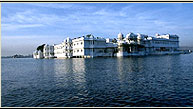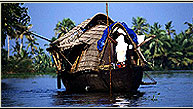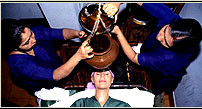-| Nagarjuna Konda | -
Location: (Andra Pradesh) - Lat 16º 31'N, Long 79º 14' E

Located 150 kms. from Hyderabad, Nagarjuna Konda or Nagarjuna Hill was named
after the Buddhist scholar and saint Acharya Nagarjuna. The site is situated
in Macherla Mandal of the district Guntur, Andhra Pradesh in South India. The
ancient township has submerged under the third largest manmade lake caused by
the Nagarjuna Sagar Dam built across Krishna river. It is approachable by motor
launches operating from Vijaypuri South. Macherla is the nearest railway station
located 24 kms. west of Vijaypuri south.
The crescentic fertile Krishna velley, girdled on three side by high hill of
NallaMala range, offered its cradle to the nomadic prehistoric man. Buddhist
probabely entered the Krishna valley during the life time of master (Lord Buddha
period) with the branching of the Mahasanghikas from the orthodox Hinayana in
the second Buddhist council at Vaishali (Bihar). The valley became a vibrant
centre of the dissident Buddhist Sangha. Amarvati and Nagarjunakonda (Sriputa)
nourished the Mahasanghikas schism (order). Due to the ardent efforts of Acharya
Nagarjuna, the valley developed into being the nucleus of Buddhist studies.
Inscriptions found at the site bespeak that it attracted the attention of royality,
merchantile elite and zealous missionaries alike from the far-off regions.
The century of Ikshvaku rule witnessed an unprecedented architectural and sculptural
activity in the region due to economic prosperity enjoyed by capital Vijaypuri
owing to an uninterrupted trans-oceanic trade with the Roman and Byzantium empire
through the east coast. Man and women of every strata from royality to monk
patronized these artistic pursuits. The Buddhist monastic layout evolved at
the Nagarjunakonda comprised the plan of well developed stupas, aspsidal stupas
and Buddhist shrine and a hall of congregation for meditation and cell for monk
to live. There were more important stupas built independently including the
earliest and the largest Mahachaitya which were of Sarrika type (with body relics).
Characterstic of plan of spoked wheel, a yoke platform in cardinal direction,
carved limestone veneering and railing were the architectural features of Buddhidt
edifices. Most of them yielded the relics of the revered Teacher and his chief
disciples in a variety of caskets.




